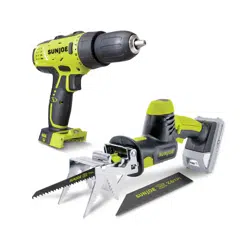Loading ...
Loading ...
Loading ...

13
Metal Cutting
You may use the saw to cut metals such as sheet steel, pipe,
aluminum, brass, and copper with the equipped metal blade.
Pay attention to the following tips when metal cutting:
• Be careful not to twist or bend the saw blade.
• Do not force the tool and use a slow speed.
• Use cutting oil when cutting soft metals and steel. Cutting
oil also keeps the blades cool, increases cutting action,
and prolongs blade life.
• Never use gasoline since normal sparking of motor could
ignite fumes.
• Clamp the workpiece rmly to eliminate any vibration of
the work. When cutting conduit pipe or angle iron, clamp
the workpiece in a vise if possible and cut close to the
vise. To cut thin sheet material, “sandwich” the material
between hardboard or plywood and clamp the layers to
eliminate vibration and material tearing.
• Always keep rm pressure on the guide plate to hold it
securely against the workpiece.
Maintenance
mWARNING! Always switch the product o and remove
the battery before performing inspection, maintenance, and
cleaning work.
1. Keep all safety devices, air vents and the motor
housing free of dirt and dust as far as possible. Wipe
the equipment with a clean cloth or blow it down with
compressed air at low pressure.
2. It's recommended to clean the equipment immediately
every time after use. Use a moistened soft cloth to wipe
the plastic housing. Do not use solvents to clean it. Never
let any liquid get inside the tool; and never immerse any
part of the tool into any liquid.
mWARNING! Do not at any time let brake uids,
gasoline, petroleum-based products, penetrating oils, etc.,
come in contact with plastic parts. Chemicals can damage,
weaken or destroy plastic which can result in serious personal
injury.
3. Apply oil on the blade and rub the oil over the cutting
area.
4. Inspect the product before each use for worn and
damaged parts. Do not operate it if you nd broken and
worn parts.
Storage
When store the tool, proceed as follows:
• Remove the battery from the compartment.
• Clean the product as describe above.
• Store the tool with the battery and charger in a secure
and dry location out of reach of children. The storage
temperature must always remains in the range of 41°F
(5°C) to 104°F (40°C).
Disposal
Recycling the tool
• Do not dispose of electrical appliances as unsorted
municipal waste. Use separate collection facilities.
• Contact your local government agency for information
regarding the collection systems available.
• If electrical appliances are disposed of in landlls
or dumps, hazardous substances can leak into the
groundwater and get into the food chain, damaging your
health and well-being.
• When replacing old appliances with new ones, the retailer
is legally obligated to take back your old appliance for
disposal at least free of charge.
Recycling + Disposal
The product comes in a package that protects it against
damage during shipping. Keep the package until you are
sure that all parts have been delivered and the product is
functioning properly. Recycle the package afterwards or keep
it for long-term storage.
WEEE symbol. Waste electrical products should not
be disposed of with household waste. Please
recycle where facilities exist. Check with your local
authority or local store for recycling regulations.
Battery Caution + Disposal
Always dispose of your battery pack according to federal,
state, and local regulations. Contact a recycling agency in your
area for recycling locations.
mCAUTION! Even discharged battery packs contain
some energy. Before disposing, use electrical tape to cover
the terminals to prevent the battery pack from shorting, which
could cause a re or explosion.
R
Fig. 12
Loading ...
Loading ...
Loading ...
